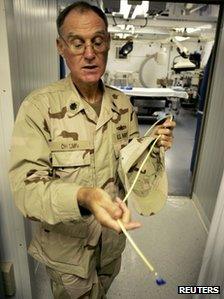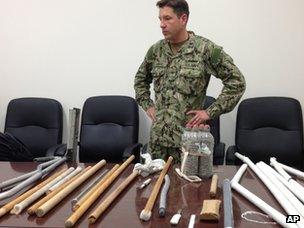Inside Guantanamo Bay's 'longest hunger strike'
- Published
Jonathan Beale visits "Camp Five" where the Guantanamo hunger strike started
Hunger strikes are not new in Guantanamo. Journalists who have visited the camp are routinely taken to the medical centre.
There a US military doctor will explain how they deal with "detainees" who refuse food for any period of time.
Sometimes the doctor will tell you that he's carried out the procedure on himself to know what it feels like.
Though for him it's probably just the once.
Detainees, some of whom have now been on hunger strike for months, will have been put through the discomfort many times.
A long tube is inserted in the nose and then fed through to the stomach, all to ensure the individual is kept alive.
It's clearly not always done willingly.
I've seen the chair in which detainees are strapped down while the procedure is carried out.

Feeding tubes are fed through the stomach to keep the individual alive
But the military staff at Guantanamo insist it is in keeping with the camps motto of "safe, humane, legal and transparent" treatment.
The last thing they want is for a detainee to die on their watch.
The six suicides that have already taken place over the years have hardly helped Guantanamo's image.
This time the scale of the hunger strike though is impossible to ignore. Dozens of extra medical staff have had to be drafted in.
A Guantanamo military spokesman has admitted that 100 of the 166 detainees still held there are now involved in the protest.
Lawyers of those protesting say the hunger strike is even more widespread.
One journalist who visited Guantanamo recently described how guards were having to deal with an increasing number of "code-yellow" alerts, prompted by concern over a detainee's condition.
Lawyers representing some of those on hunger strike say they are regularly collapsing through weakness as the protest takes its toll.
'Heavy-handed treatment'
The protest appears to have been sparked by one specific incident.
On 6 February, guards searched Camp Six, where the more co-operative prisoners are normally held.
It is reported that the search uncovered unspecified contraband and a number of items were seized. Detainees complained that Korans were also mishandled in the search.
So began what has become the longest hunger strike in the prison.
Conditions at Guantanamo had, until then, seemed more relaxed.

Prisoners used "improvised weapons" during clashes with guards on 13 April
In Camp Six, most detainees were allowed to mix together, with access to satellite TV and phone calls to lawyers.
Some detainees were even allowed to Skype their families back home. But life there has now become tense.
On 13 April, prisoners and guards clashed in communal cellblocks. Officials said some prisoners used "improvised weapons".
In response, US guards fired "four less-than lethal rounds".
The US military said they went in only after detainees had covered surveillance cameras and windows preventing round-the-clock observation.
After the incident, the commander at Guantanamo ordered detainees held at Camp Six back into single cells.
Lawyers see the protest as a reaction to "heavy-handed treatment".
But it does appear to be co-ordinated and designed to attract attention.
In my several visits to the camp, it would appear that conditions have improved.
But that will not have addressed the lingering anger over being held for years without trial.
Obama campaign promise
Of course if President Obama's orders had been followed, Guantanamo would have long been closed.
He campaigned on a promise to shut it down within a year.
The president's wishes though were soon thwarted by Congress, with both Democrats and Republicans blocking any attempt to transfer detainees for trial in US federal courts.
On Tuesday, President Obama said he was going to try again to close down the prison.
But despite this, he may feel his hands are tied.
The state department special envoy, tasked with finding third countries willing to take those detainees cleared for release, has recently been "re-assigned".
The trickle of prisoners leaving Guantanamo for Saudi Arabia or even Bermuda has now stopped.
And reports that some Guantanamo detainees have "returned to the battlefield" may have also hardened public opinion.
The president may be wary of allowing dozens of detainees to return to Yemen. But the bottom line is that most detainees have been "cleared for release".
Very few have been charged with terrorist offences. That sense of "injustice" will have to be addressed.
- Published30 April 2013
- Published30 April 2013
- Published17 April 2013
- Published13 April 2013
- Published16 October 2012